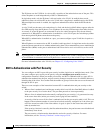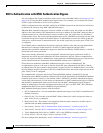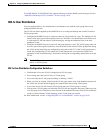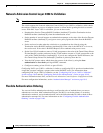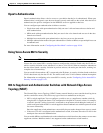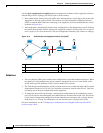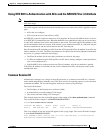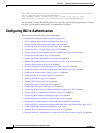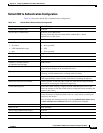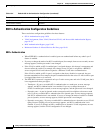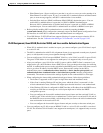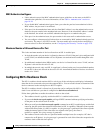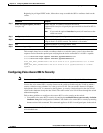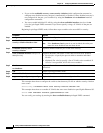
10-35
Catalyst 2960 and 2960-S Switch Software Configuration Guide
OL-8603-09
Chapter 10 Configuring IEEE 802.1x Port-Based Authentication
Understanding IEEE 802.1x Port-Based Authentication
Using IEEE 802.1x Authentication with ACLs and the RADIUS Filter-Id Attribute
Note To use IEEE 802.1x authentication with ACLs and the Filter-Id attribute, the switch must be running the
LAN base image.
The switch supports both IP standard and IP extended port access control lists (ACLs) applied to ingress
ports.
• ACLs that you configure
• ACLs from the Access Control Server (ACS)
An IEEE 802.1x port in single-host mode uses ACLs from the ACS to provide different levels of service
to an IEEE 802.1x-authenticated user. When the RADIUS server authenticates this type of user and port,
it sends ACL attributes based on the user identity to the switch. The switch applies the attributes to the
port for the duration of the user session. If the session is over, authentication fails, or a link fails, the port
becomes unauthorized, and the switch removes the ACL from the port.
Only IP standard and IP extended port ACLs from the ACS support the Filter-Id attribute. It specifies the
name or number of an ACL. The Filter-id attribute can also specify the direction (inbound or outbound)
and a user or a group to which the user belongs.
• The Filter-Id attribute for the user takes precedence over that for the group.
• If a Filter-Id attribute from the ACS specifies an ACL that is already configure, it takes precedence
over a user-configured ACL.
• If the RADIUS server sends more than one Filter-Id attribute, only the last attribute is applied.
If the Filter-Id attribute is not defined on the switch, authentication fails, and the port returns to the
unauthorized state.
Common Session ID
Authentication manager uses a single session ID (referred to as a common session ID) for a client no
matter which authentication method is used. This ID is used for all reporting purposes, such as the show
commands and MIBs. The session ID appears with all per-session syslog messages.
The session ID includes:
• The IP address of the Network Access Device (NAD)
• A monotonically increasing unique 32 bit integer
• The session start time stamp (a 32 bit integer)
This example shows how the session ID appears in the output of the show authentication command.
The session ID in this example is 160000050000000B288508E5:
Switch# show authentication sessions
Interface MAC Address Method Domain Status Session ID
Fa4/0/4 0000.0000.0203 mab DATA Authz Success 160000050000000B288508E5
This is an example of how the session ID appears in the syslog output. The session ID in this example
is also160000050000000B288508E5:
1w0d: %AUTHMGR-5-START: Starting 'mab' for client (0000.0000.0203) on Interface Fa4/0/4
AuditSessionID 160000050000000B288508E5




